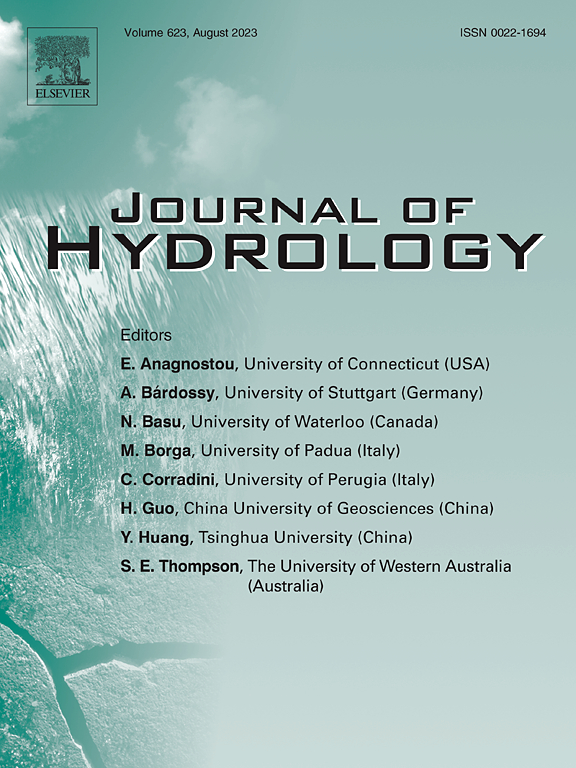Improvement of rootzone soil moisture estimation over the Tibetan Plateau based on the exponential filter model and Copernicus Climate Change Service (C3S) surface observations
IF 6.3
1区 地球科学
Q1 ENGINEERING, CIVIL
引用次数: 0
Abstract
This study is the first attempt to assess and enhance the applicability of exponential filter (ExpF) model to estimate rootzone soil moisture (RZSM) across different climatic and land conditions over the Tibetan Plateau (TP). To this end, in situ soil moisture (SM) profile data collected from five regional-scale monitoring networks are firstly used for the model assessment at local scale. Then a random forest (RF) approach is adopted to regionalize the critical model parameter (i.e. characteristic time length ) to enhance the estimation of RZSM at plateau scale using satellite-based surface SM (SSM) data from the Copernicus Climate Change Service (C3S). Results indicate that with increasing soil depth, the application accuracy of the ExpF model decreases due to weakened coupling strength between the SSM and RZSM, while the T values and their spatial heterogeneity increase due to greater variability in hydraulic connectivity between the SSM and RZSM across different monitoring sites. From the arid west TP to the semi-arid and humid east TP, the application accuracy of the ExpF model increases, while the variability in model accuracy across different monitoring sites shows a decreasing trend. The spatial distribution of regionalized T values at shallower depth is opposite to that of sand content, with higher values in the northwest TP and lower values in the Qaidam basin and central TP. For the deeper depth, higher values are also noted in the southeast TP due to the increasingly significant impact of meteorological and vegetation factors. The RZSM estimations based on the ExpF model with the regionalized T values capture better the observed dynamics and largely resolve the deficiencies noted for the C3S-based RZSM product. Above findings confirm the applicability of the ExpF model on the TP, offering valuable insights into enhancing the accuracy of RZSM estimations based on the satellite-based SSM products.
基于指数滤波模型和哥白尼气候变化服务(C3S)地表观测的青藏高原根区土壤水分估算改进
本研究首次对指数滤波(ExpF)模型在青藏高原不同气候和土地条件下估算根区土壤湿度(RZSM)的适用性进行了评估和增强。为此,首先利用5个区域尺度监测网络的原位土壤湿度剖面数据进行局地尺度的模型评价。然后采用随机森林(RF)方法对关键模式参数(即特征时长T)进行区域化处理,以增强基于卫星的哥白尼气候变化服务(C3S)地表SM (SSM)数据在高原尺度上的RZSM估计。结果表明,随着土壤深度的增加,由于SSM与RZSM之间的耦合强度减弱,ExpF模型的应用精度降低,而不同监测点SSM与RZSM之间的水力连通性变异性较大,T值及其空间异质性增加。从干旱的青藏高原西部到半干旱湿润的青藏高原东部,ExpF模式的应用精度呈上升趋势,而模式精度在不同监测点间的变异率呈下降趋势。浅埋区域化T值的空间分布与含砂量的空间分布相反,表现为青藏高原西北部较高,柴达木盆地和中部较低。由于气象因子和植被因子的影响日益显著,东南TP区深度越深,值也越高。基于区域化T值的ExpF模型估算的RZSM能更好地捕捉观测动态,并在很大程度上解决了基于c3s的RZSM产品的不足。上述发现证实了ExpF模型在TP上的适用性,为提高基于卫星SSM产品的RZSM估计精度提供了有价值的见解
本文章由计算机程序翻译,如有差异,请以英文原文为准。
求助全文
约1分钟内获得全文
求助全文
来源期刊

Journal of Hydrology
地学-地球科学综合
CiteScore
11.00
自引率
12.50%
发文量
1309
审稿时长
7.5 months
期刊介绍:
The Journal of Hydrology publishes original research papers and comprehensive reviews in all the subfields of the hydrological sciences including water based management and policy issues that impact on economics and society. These comprise, but are not limited to the physical, chemical, biogeochemical, stochastic and systems aspects of surface and groundwater hydrology, hydrometeorology and hydrogeology. Relevant topics incorporating the insights and methodologies of disciplines such as climatology, water resource systems, hydraulics, agrohydrology, geomorphology, soil science, instrumentation and remote sensing, civil and environmental engineering are included. Social science perspectives on hydrological problems such as resource and ecological economics, environmental sociology, psychology and behavioural science, management and policy analysis are also invited. Multi-and interdisciplinary analyses of hydrological problems are within scope. The science published in the Journal of Hydrology is relevant to catchment scales rather than exclusively to a local scale or site.
 求助内容:
求助内容: 应助结果提醒方式:
应助结果提醒方式:


